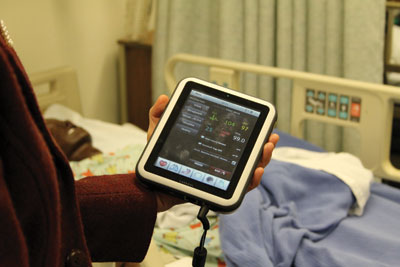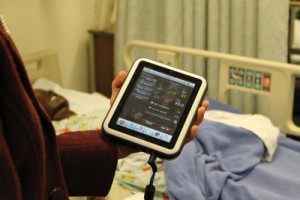Technology is transforming nursing education on campus
From Sim patients to electronic health records to healthcare-specific app, technology is also revolutionizing the way nursing is taught. Soon, the nursing classroom itself could look vastly different.


Nurses today can be considered “mini-engineers,” explains Marcia Blicharz, because of the wide array of high-tech equipment they work with on a daily basis. From modern emergency and operating room settings, where robots assist in delivering care, to private practitioners’ offices and hospital units, where barcoding equipment is used to deliver medications, “technology is everywhere in the practice of nursing,” Blicharz said.
Not surprisingly, technology is also revolutionizing the way nursing is taught here at the College, Blicharz, the interim dean of the School of Nursing, Health, and Exercise Science, said.
Take for instance the newest “resident” of the Dr. Gladys M. Word Nursing Simulation Laboratory in Paul Loser Hall. Last fall, the lab acquired a “SimKid,” an electronic mannequin made to mimic a 6-year-old. SimKid joined two adult mannequins and a baby mannequin; together, the lifelike dummies are used to simulate any number of medical scenarios, helping nursing students learn how to make clinical decisions to best deliver care.
“[The mannequins] breathe. Their pupils dilate. They can go into cardiac arrest. They can mimic postpartum hemorrhaging,” explained Blicharz. “We have simulations/scenarios [using the mannequins] incorporated into all of our major clinical courses.” The new SimKid even features wireless capabilities, which allow faculty to change scenarios on the fly, making the learning process more realistic. These high-tech, simulated learning experiences “supplement and enhance” the work that nursing students do in their on-site clinical assignments, Blicharz said.
Another change ushered in by technology: TCNJ nursing students are being trained to use electronic health records (EHRs).
“There is a huge push nationally for implementing electronic health records, so that hospitals, doctor’s offices, immunization clinics, and the like can better communicate with one another,” Blicharz said. Despite legislation meant to promote the adoption of EHRs into the healthcare system, Blicharz said fewer than 19 percent of the nation’s hospitals have done so. Still, EHRs represent the future, she said: They can reduce errors and increase safety, thus improving the accuracy and quality of care that is delivered, and they can cut down on paperwork, helping to reduce costs.
TCNJ nursing students have been using EHRs in simulated and classroom settings since 2009, Blicharz said. Complicating the matter, though, is the absence of any standardized format. TCNJ students use the Neehr Perfect system. Many of the agencies in which TCNJ’s students perform clinical experiences use different EHR systems. “So it’s a new system the students must learn each time,” she said.
Add to this the increased presence of e-textbooks, tablets, and smart phones, and healthcare-specific apps that today’s students are using, and it’s easy to see how different the scene in today’s nursing classrooms looks compared to more than 30 years ago, when Blicharz started teaching at the College.
Soon, the classroom itself could look vastly different. Asked what changes technology could bring in the future, Blicharz said there is a growing push in nursing schools to incorporate virtual worlds. These computer-simulated settings allow students to practice delivering care to all family members, and even to entire communities. “And that’s where the big move is these days, to do everything—assess, treat, and evaluate—across the community,” explained Blicharz.
Posted on March 1, 2013

